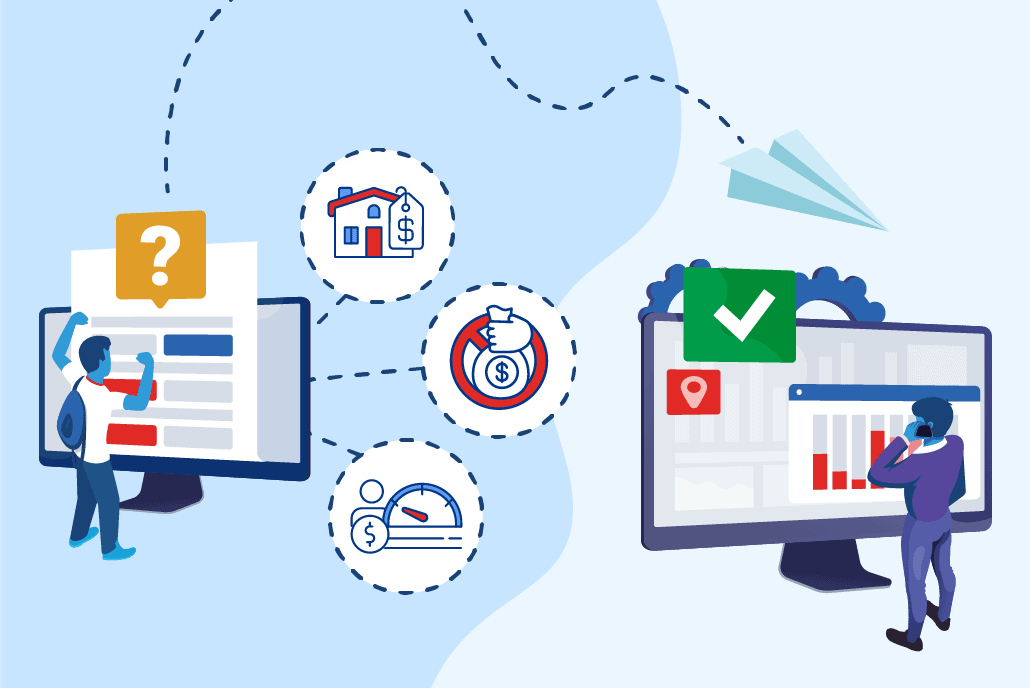Introduction
The introduction of technology has undoubtedly altered the way things work in the world. Credit underwriting used to be a time-consuming and daunting task for applicants who relied on traditional banking and other offline sources for loans. Credit underwriting has had to develop to meet customers’ expectations now that financing is available through digital platforms.
The automated underwriting system can perform the entire loan approval workflow, from gathering data from various underwriting papers to comparing the collected information against third-party data from banks, creditors, lenders, and other financial organizations to generate an analysis report.
Forbes has reportedly mentioned that automation stands to save a large amount of money for the organizations, and in some cases, it is as much as $4 million a year.
What is an Automated Underwriting Solution?
Underwriting is a process of assessing the risk of a financial transaction such as a bond issue, bank loan, or insurance policy. With the boost in FinTech, the lending industry is also moving towards the swift adoption of innovative technology. Automated underwriting is a technology that evaluates risk and underwrites loans, accordingly, using Automated Underwriting Solution (AUS).
Automated underwriting takes loan-related decisions based on robust algorithms rather than relying on human beings. It eliminates the risk of human error, misinterpretation of loan-related risk, and biasing while making decisions. Therefore, automation makes the underwriting process more reliable and quicker for both lenders and borrowers.
How does Automated Underwriting Solution work?
An Automated Underwriting System uses Robotic Process Automation (RPA) and Machine Learning (ML) to collect and examine the client’s financial information. The information is analyzed to generate recommendations on whether the loan should be approved, or rejected, or which other conditions the client needs to fulfill to get approval for the loan. The system then chooses whether to consent to a customer’s mortgage application or submit it to a manual underwriter.
Automated Underwriting Software has either of these two types of working mechanisms:
A) Pre-application credit underwriting software: As the name suggests, it takes place before the applicant submits an official loan or credit application. Pre-application credit underwriting is intended to assist the lender in analyzing different borrowers and sorting out the risky borrowers from the safe ones. This process enables the lenders to focus on the safe ones to lend the money – most likely to return the loan money.
B) Post-application credit underwriting software: post-application credit underwriting occurs after a borrower has already applied for and been granted or declined a line of credit.
Amongst some of the steps taken are:
- Validates facts obtained from the borrower’s credit report
- Acquiring soft credit data such as present employment status, salary, and number of years in service at the current job
- Using risk criteria for determining if the interest rate should be increased or decreased depending on the applicant’s rating.
- Calculating the overall debt-to-income ratio
- Making a tentative judgment on acceptance or refusal of the loan.
- Processing the data through a fraud detection system (FDS) to search for any possible irregularities, incomplete or inadequate data, etc.
The entire procedure can be split into two phases:
- The first phase consists of an application review. Examine the applicant’s earnings, previous work experience, and holdings (such as the home’s value). Applicants will almost certainly be inquired about education loans or other debt dues. Several financial institutions ask for evidence of employment and date of birth, and other supporting documents from the borrower.
- Upon completing the initial screening procedure, underwriters must choose and see if the borrower has a reasonable enough potential to pay their loan installments to make the loan profitable for lenders. Underwriters examine the details of the loan or credit card debt thoroughly at about this step to determine whether the candidate can repay the debt at all. If otherwise, the bank may choose to decline the loan application entirely.

Automated Underwriting Solution vs. Manual Underwriting
Here are some distinguishing features between manual and automated underwriting.
Customer Experience
In a developed market, manual underwriting might provide the convenience of a human approach. However, it is a highly time-consuming operation. Underwriting processing speed and accuracy are not as consistent as in automated underwriting. Customers are turned off by lengthy manual form-fills, confusing fine print, inaccuracies, inconsistencies in underwriting, slow turnaround times, and the absence of product customization.
AI-powered underwriting solutions enable companies to provide a unique customer experience during the sales process and establish confidence from the very first point of interactions with clients. It streamlines reduced complexity procedures, allowing underwriters to focus on more complex communication with customers. After that is accomplished, lenders may concentrate their efforts on developing a long-term retention strategy based on tailored client care and profitable revenue models. Given the possibilities, high-profile lenders have already trained their underwriters to handle more sophisticated duties and integrate tremendously gratifying digital platforms.
Pricing and Risk Management
During Manual underwriting, every other application introduces a new set of risk parameters that are increasingly difficult to analyze and manage. Manual underwriting suffers from excessive price, poor quality, and the threat of procedural errors.
Artificial Intelligence is used in Automated Underwriting to evaluate an approach to analyzing large data points. Underwriters obtain transparency into the most pertinent risk indicators connected with customer profiles with big data and corresponding algorithms. AI-driven Underwriting automation provides total risk insight into a particular circumstance. As a result, it facilitates recommending the best potential prices and protection to underwriters.
Operational Costs
In some business areas, the cost of manual underwriting can range from $50-130/hr, multiplied by headcount. The manual underwriting process would take somewhere between days or even weeks.
By accelerating the rise of automated underwriting, underwriters and insurance businesses can dramatically reduce operational expenses. It enables a streamlined workflow centered on Machine Learning models that can self-train and respond to the system’s patterns and peculiarities without incurring additional costs to grow exponentially.
Business growth
Manually issued insurance quotations are slower than the quotes provided by algorithms. So, if customers were to choose between the two, they would go with the one that has a relatively short processing time and is available 24 hours a day, seven days a week.
AI-based underwriting improves profitability by supporting underwriters in delivering lower loss ratios, a greater turnover rate, better converting rates, and ultimately optimizing the resource usage of the overall underwriting function.
Underwriting Efficiency
For the most high-value customers, the manual underwriting procedure might take weeks to receive a quote post-application, making it one of the most time- and resource-intensive operations in the insurance client life cycle. Furthermore, the manual nature of the task harms productivity.
AI-assisted When it comes to underwriting efficiency, underwriting is far superior. Using RPA and incorporating intelligence into the system for light and repetitive operations allows underwriters to concentrate on complicated jobs and ultimate decision making. For example, AI-powered underwriting systems can assist underwriters in issuing a quote for high-value accounts on the day of application in seconds without requiring user intervention.

10 Reasons Why Do You Need an Automated Underwriting Solution?
Those organizations that are still hesitant about the economic value of automated underwriting should glance at the following benefits of automated underwriting. This may persuade them of the promising growth.
1. Makes Better Decisions
Algorithms do not make procedural errors. No matter how competent, a human is likely to eventually experience a bad performance day, which can cost a lender million in non-performing loans. With the capacity of machine learning and more data on these loans, automated systems are becoming better at forecasting which loans would perform better.
2. Shows More Productivity
The automated credit underwriting system saves time for both parties (i.e., the lender and the borrower), leading to rapid decision making and fewer processes than manual underwriting. The automated underwriting also ensures that the borrower’s expectation for faster processing is achieved, but with integrity that does not jeopardize the lenders’ balance sheet.
3. Agile Fraud Detection
Loan fraud is becoming more prevalent and easier to commit. Credit card fraud is a multibillion-dollar business itself. Automation significantly and consistently reduces the risk of fraud. This is because the robotic system utilizes powerful predictive analytics to identify potential risks to loan disbursement to a client accurately. These procedures raise red flags whenever uncertainty is identified, allowing for improved fraud detection.
4. More Consistency
The automation allows the bank to underwrite, sanction, and document credit more personalized manner while remaining consistent with the bank’s standards. It compensates for the bank agent’s inability to comprehend bank policies, which may be unique to each employee. Furthermore, automation considers all loan-risk elements linked with critical loan policies while making the decisions regarding loans that may be overlooked in manual underwriting.
5. Effective Use of Underwriting Resources
Suppose a lender uses its automated underwriting system for overly simplistic issue products. It may avoid utilizing human underwriters for a significant proportion of policies, allowing the lender to efficiently allocate its underwriters for higher-value, more complicated matters. Suppose a lender uses its automated underwriting system for more than simplified issue policies. Even if it is primarily utilized as a routing tool, intelligent rules can indicate which kinds of applications are forwarded toward each level of underwriters, giving the improved distribution of resources through automation.
6. Reduced Paper Process
Replacing paper use by employing a data-driven automated approach saves lenders time gathering data on paper applications. Additionally, it reduces imaging expenses, the number of manual handoffs, and human failure points. Questions cannot be left blank, and handwriting cannot be misunderstood when an e-application is linked to an underwriting rules engine. At its most basic, eliminating paper from the process saves an underwriter’s money on filing, human rework, and the hassle of storing paper applications.
7. Scalability
Scalability is difficult to achieve in a typical underwriting process since understanding various documents for better classification, analysis, stacking, and extraction requires a thorough understanding of the lending business. One may need a professional team of expert analysts but doing so will cost a fortune. This situation can be avoided through automated underwriting. A single system can handle the entire underwriting process without costing too much. Rather than reviewing each instance, the analysts will concentrate on improving the system.
8. Convenient Auditing
Automation of documenting processes simplifies the documenting and lending processes, allowing for quicker and less time-consuming audits. This benefits traditional banks and credit unions by facilitating accuracy and reducing fraud.
9. Promising Customer Experience
More organizations use automated underwriting, so more individuals and businesses looking for finance regard it as a must-have in a financing partner. Automated underwriting aims to provide the consumer with a quick, simple application procedure while preserving the lender’s risk tolerance and regulatory compliance for the decision.
Some of the solutions that an automated underwriting process provides making it highly preferable for both the lender and the borrower are:
- better process flow
- higher customer service levels
- increased agency communications
- improved tracking
- more consistent underwriting choices
- faster throughput
- better mortality
10. Greater Profit Margins
Indeed, by replacing innumerable human staff members with a single algorithmic system, automated underwriting can significantly increase an insurance company’s profitability. Despite the development and maintenance costs, this can save your insurance company thousands of dollars – and you won’t be the only one who benefits. You may also pass on the savings to your customers, making it a win-win situation.
Conclusion
Credit underwriting automation does not decrease the significance of humans in determining creditworthiness. It has been improved since analysts are now equipped with solid algorithms that handle the hard lifting in pattern recognition and repetitious jobs. Automated credit underwriting has changed the credit underwriting process with online lending causing havoc in the traditional lending business. While automated underwriting began with loan startups, it has already spread to the traditional banking industry and continues to grow and make profits for organizations and individuals.
Download a whitepaper to understand how Liventus can help you provide a solution.
About the Author
Dan Levin – President
Dan is a founding member of Liventus and currently serves as the President. He oversees business operations and growth and manages software development.


